

European
Nuclear Society
e-news
Issue 25 July 2009
Concern about reducing CO2 emissions and maintaining adequate supplies of energy, as well as a healthy dose of common sense, have led many people to lend their support, sometimes enthusiastically and sometimes reluctantly, to the nuclear bandwagon. As nuclear energy’s pariah status has decreased public acceptance of it has increased and the latest public opinion polls have revealed that there is now virtual parity between those who are in favour and those who are against nuclear energy (44% - 45%). More people than ever before are now prepared to listen to the nuclear case. But one issue above all continues to cast a shadow over growing public acceptance, the thorny question of what to do with the radioactive waste. Traditionally the public has always been more aware of the “inherent dangers” of radioactive waste rather than of the existence of safe technological solutions for handling it. The anti-nuclear lobby never misses an opportunity to conjure up apocalyptic visions of what will happen if even more waste is produced and this has, to a large extent, conditioned the public’s thinking on the subject. But what can we do to effectively reverse the situation? The secret lies in knowledge. Canvassing of public opinion has shown that the more people know about nuclear energy the more they are in favour of it. What’s more, support for nuclear energy would be even greater if the public was reassured that the waste is being handled safely and in a sustainable way. So, greater knowledge of nuclear energy in general and of available waste management solutions in particular, would empower citizens to make informed judgements about nuclear energy. This empowerment would put more pressure on decision-makers to show the will needed to drive forward a common EU-wide legislative framework for waste and to create a sound platform upon which the future of nuclear energy could develop. This would enable Europe’s nuclear research effort to move up a gear and put the emphasis on solutions, not problems.
It’s crucial, therefore, that we – both the scientific community and industry - start getting our message across with as much impact and conviction as our ideologue opponents. With ambitious new build programmes in place in a number of European countries, communicating successfully is more than ever a sine qua non.
It would be true to say, however, that the debate about radioactive waste has intensified, with increased coverage of the issue in the media and greater involvement of stakeholders in the decision-making processes. In early June, for example, it was announced that, following lengthy stakeholder discussions, the Swedish power utility, Vattenfall, had chosen the Forsmark NPP as the location for Sweden’s first operational deep geological repository for radioactive waste. The new site will store long-lived highly radioactive waste from the country’s 10 nuclear reactors deep underground in Sweden’s granite rock formation. Increased exposure to the facts is gradually filtering through, but perhaps not as much or as quickly as it needs to. There are many other research activities that have delivered solutions that the public ought to know more about. Finland, for example, will also have a deep geological repository operational in the near future, at Posiva’s Onkalo site. Extensive research into the suitability of salt as a host substance is being carried out at the underground laboratory in Gorleben, Germany. The site could provide a suitable deep geological storage site some time in the future, if the political climate in Germany were to change. Then there is the advanced research into the suitability of clay as a host substance that is being done by SCK-CEN in Mol (Belgium), by ANDRA in Bure (France) and at Grimselpass, in Switzerland. In addition, the capacity for Generation IV reactors to create less waste in the future is another important focus of research that the public ought to know about. With more information on the relevant research available on public websites and press and public visits to research facilities on the increase, a lot is being done to try and bridge the public knowledge deficit. But more can always be done.
After increasing the public’s knowledge of the facts, the next major challenge is influencing the political process. Politicians must also see the light and be persuaded to show the requisite political will to transform successful research into everyday practical solutions. But what is happening in Europe’s corridors of power? Well, the European Nuclear Energy Forum (ENEF) and the Sustainable Nuclear Energy Technology Platform (SNETP) continue to play a vital role in channelling political efforts into supporting nuclear energy. Furthermore, once the EU’s much-anticipated Nuclear Safety Directive is adopted, it is generally believed that the next big legislative heavyweight in the pipeline is a Directive on radioactive waste. It is hoped that this legislation will go a long way to creating the common legal framework on radioactive waste that everyone so craves. More importantly, it would enable the achievements of research to get the recognition that they so richly deserves. Increasing knowledge of nuclear energy based on the facts, coupled with greater political will; that is the winning formula that could go a long way to securing the legacy and future contribution of nuclear energy.
ENS NEWS would like to hear the latest news from ENS members about the work they are doing in the field of radioactive waste management, or about what they are doing to engage the public more. ENS NEWS is accessible to the public via the ENS website. Your views and the information you provide could further fuel this important debate.
ENS NEWS N° 25 kicks off with the traditional Word from the President piece, which on this occasion focuses on the recent European Nuclear Young Generation Forum conference (ENYGF09), in Cordoba, Spain, and on the key role that the YGN network plays within the ENS family.
Andrew Teller’s regular column then explores the correlation between electricity generation and the human development index, a UN compiled index for evaluating the degree of human well-being in every country based on factors like life expectancy at birth, level of education and Gross Domestic Product. One of the conclusions he reaches is that the view that energy conservation alone will answer tomorrow’s energy need is, to say the least, a simplistic one.
There are four major conferences under the spotlight in this edition’s ENS Events section: TOPFUEL, which takes place in Paris from 6 - 9 September 2009; ETRAP, from 8 -12 November, in Lisbon; PIME 2010, which takes place from 14 -17 February, in Budapest and ENC 2010, which will take place in Barcelona, from 30 May - 3 June 2010.
ENS NEWS N° 25 contains a bumper Member Societies and Corporate Members section that includes reports on, among other things, the recent meeting of the European Atomic Energy Society, in Slovakia; a critical analysis of the pollution status around France’s nuclear sites, environmentally-conscious Sweden’s continuing use of nuclear energy and a detailed look at the Guinevere experiment being carried out at SCK-CEN, in Mol.
The YGN section provides two reports: the first is a detailed and personal account by a YGN “roving reporter” of the ENYGF09 conference in Cordoba, Spain, which the President mentioned in his opening piece, and the second is an analysis of the evolving political, and rather controversial, cause célèbre about a potential lifetime extension of the Garoña NPP, in Spain.
The ENS World News section opens with an article about the ongoing boom in nuclear qualifications being gained by young people in the US, which is a response to the gathering momentum of the global nuclear revival and the increasing attraction of a career in nuclear science. Next up is a selection of interesting press reports from the NucNet team. Finally, there is the latest news regarding upcoming ENS conferences.
On behalf of ENS NEWS I would like to wish you and yours a great summer and I hope that you will return relaxed, rested and raring to go.
All the best!
|
|
http://www.euronuclear.org/e-news/e-news-25/presidents-contribution.htm


Among the many duties that I perform as President of ENS one of the most pleasurable is to work closely with the Young Generation Network on a number of interesting projects. Being surrounded by so much youthful dynamism and commitment is a constantly rejuvenating process. I am also regularly reminded of the crucial role that the Network plays in raising and discussing the contemporary issues that really count, in bridging the knowledge gap between the older and younger nuclear generations and in acting as a catalyst to motivate and support the emerging scientists who will help define the future direction and progress of ENS. In many ways the YGN functions like the perfect mayonnaise, a high-performance emulsifier that binds together the necessary ingredients, allows each to interact correctly and contributes to a perfect end product!
In May this year, I was fortunate to chair part of the 2009 European Nuclear Young Generation Forum (ENYGF09), in the beautiful Spanish city of Cordoba. And all the right ingredients were there to make a perfect conference – a varied and pertinent agenda, a host of highly-qualified guest speakers (including Luis Echavarri, Director General of the OECD/NEA and Alejo Vidral-Qadras, MEP and former Vice president of the European Parliament) plenty of open and dynamic debate, some key messages worthy of being communicated to a wider public and an inspiring setting and working environment. I will not go over the conference programme in too much detail as ENS NEWS N° 25 features an interesting report from one of our YGN “roving reporters” that does just that. Instead, I would like to briefly outline what were, for me, some of the outstanding messages to emerge from the conference. I will then highlight one or two individuals whose contribution to the work of the YGN, and ENS as a whole, is worthy of special praise.
Among the main issues that were rightly identified and discussed during the conference was the crucially important one of providing essential training and education. This is vital to ensuring that the acquired knowledge and legacy of previous generations, thanks to good communications and interaction, is passed on to the current and future generations of nuclear scientists. Knowledge is empowerment and this in turn will help prepare tomorrow’s nuclear leaders. Within this context the role of the YGN in facilitating knowledge transfer is crucial. With the nuclear sector experiencing such a rapid worldwide expansion at the moment, the onus upon quality education, training and effective communications is all the greater.
Another important issue discussed at length in Cordoba was that of nuclear safety and how it is a fundamental vector in securing and nurturing improved public acceptance. Indeed, the issue of safety and public acceptance was the focus of a whole afternoon session. It is of paramount importance to effectively communicate how current and future reactors are intrinsically safe and how existing radioactive waste management solutions are too. If these key messages are successfully communicated to the general public then it will accept nuclear energy even more readily. This fact is backed up by the results of successive public opinion polls that have shown that if safety and waste management were perceived as less of a problem then even more citizens would support nuclear energy. Clear and reliable communications that address the real concerns of the public are, therefore, the key. They can also help to dispel the myths about nuclear energy - and here again the YGN can and does play a telling role. In fact, the importance of using high-impact communications strategies to convey the facts about nuclear energy was a constantly recurring theme throughout the conference.
In addition to the lively conference debates there were also a number of more formal and administrative events during ENYGF09 at which I was delighted to officiate. There are a couple of people who have been closely associated with the YGN over the years who I would especially like to thank; their tireless support and stalwart contribution has been invaluable to the prosperity of the YGN and to the ENS family in general: first of all, Igor Vukovic’s term as President of the YGN has come to an end and I would like to thank him for the outstanding leadership he has shown in the role. His seemingly boundless energy and ability to work with people to get things to happen have helped the YGN to drive forward with even greater impact.
Secondly, in his role as Chairman of the Belgian Nuclear Society Marcel Maris’ has always been a great promoter of the aims and activities of the Belgian chapter of YGN – and of the YGN in general. That priceless support received the recognition it so richly deserved when he was awarded, during ENYGF09, the prestigious Jan Runemark Award for outstanding services to the YGN. I would like to offer once again my sincerest thanks and congratulations to Marcel. Long may our fruitful collaboration continue!
In many ways the YGN is the youthful heartbeat of the nuclear science community. To have the opportunity to work with them provides everyone, the young and the not-so-young, with an injection of energy and optimism for the future. And friendships made by membership of the YGN give access to a great, international network that will prove to be invaluable throughout a nuclear career. I am sure that you would agree with me that their contribution is a vital one to the Society and to the nuclear science community as a whole. I look forward to continuing to work with YGN in the future.
Wherever you are during the summer holidays, enjoy it and return rested and refreshed to meet the challenges that lie ahead
http://www.euronuclear.org/e-news/e-news-25/listening.htm


So many people keep believing that energy conservation – the famous negawatts – will provide the answer to tomorrow’s energy needs. It is therefore worth devoting this column to another approach that highlights the consequences of relying too much on savings. In a paper written in 20001, Alan D. Pasternak shows that forecasts failing to take human development needs into account can only seriously underestimate the world’s future energy requirements.
His argument is based on the use of the Human Development Index (HDI), a measure of human well-being compiled annually by the United Nations for each and every country. This index is a combination of life expectancy at birth, level of education and Gross Domestic Product (GDP) per capita. It ranges from a theoretical minimum of zero (for a life expectancy = 25 years, complete illiteracy and a GDP per capita = $100 at purchasing power parity) to a theoretical maximum of one (for a life expectancy = 85 years, 100% literacy and a GDP per capita = $40,000 at purchasing power parity)2 . In practice, the observed range is 0.3 – 0.97. Charting the HDI against the yearly electric consumption per capita, A. Pasternak obtains figure 1, from which he observes that 4,000 kWh per capita constitutes a threshold.

The reasons for choosing 4,000 kWh are the following. No country with an electric consumption below 4,000 kWh has an HDI above 0.9 and, barring four cases (South Africa, Saudi Arabia, Russia and South Korea), all countries consuming more than this value per capita have an HDI greater than 0.9. This observation is then used to assess the consequences of growth scenarios assuming that, over the 2000 – 2020 time frame, an increasing number of countries reach or exceed the 4,000 kWh threshold. This assumption is combined with the universally accepted assumption that world population will keep growing over the same period. The resulting electricity, and hence primary energy, requirements are indeed noticeably higher than those obtained without taking the human development factor into account. Comparisons with forecasts by the US Department of Energy show that Pasternak’s figures are 50 to 100% higher. The author also demonstrates in his paper that correlating HDI with electricity consumption gives better results than with primary energy consumption. Figure B-1 shows the logarithmic relationship between HDI and kWh/capita, which gives a correlation factor R² higher than 0.84, indicating a good fit3. Fitting a curve on HDI plotted against primary energy consumption would yield an R² of about 0.80.
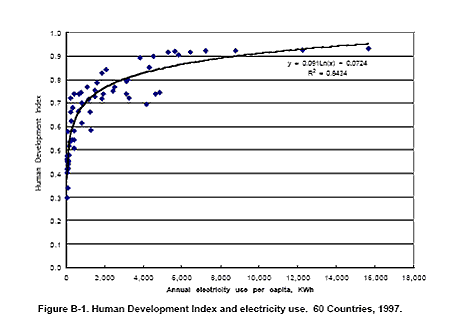
The paper concludes that its “estimates of electricity use associated with high levels of human development […] argue for substantially increased energy and electricity supplies in the developing countries and the formulation of supply scenarios that can deliver the needed energy within resource, capital and environmental constraints. Neither the Human Development Index nor the Gross Domestic Product of developing countries will increase without an increase in electricity use”.
This, I thought, was an argument for the development of nuclear energy that nobody would be able to deny. Well… not exactly: I found on the Internet another paper4 that uses the same line of reasoning but – unexpected to me – reaches the conclusion that HDI increases can be achieved without raising the world’s energy consumption. Its author, Manuel Garcia, proceeds in four steps. First, he uses a different formula for trend fitting displaying a stiffer bend (see curve in red on figure 2, the curve in blue is based on the abovementioned logarithmic law).

This enables him to choose the lower threshold of 2,000 kWh/capita. Second, he considers that, while all low consumption countries would increase their use of electricity, the richest ones would decrease theirs by 6,000 to 8,000 kWh/capita. This, he reckons (no details given), would require a doubling of the current (2006) world electricity needs. Third, he makes no allowance for population growth. Fourth, he submits that the aforementioned doubling could be taken care of mainly by energy conservation measures and by increasing energy efficiency. Granting for a moment that these measures would suffice in the case of a doubling of the requirements, would they still be enough if the needs triple, as would be the case once population growth is included in the picture?
While Pasternak’s paper clearly constitutes much better research than the second one (more on this in the technical appendix), there seems to be one point both papers have missed: the nature of the correlation between electricity and HDI remains mysterious in both cases. Is there really a causal relationship between electricity use and HDI? Alan Pasternak seems to believe it since he sees an increase of the former as the path to increasing the latter, as indicated by the quotation reproduced above. Similarly, in the second paper, a trend curve fitted on the dots of the chart is considered as providing a one-to-one relationship that links the two variables: moving the electricity consumption will set the HDI moving in accordance on the curve. But correlation is not causation and it is easy to find examples supporting this statement. The most convincing I know is the following one. Would the reader please note that there is a clear, positive correlation in the reading ability of children and the length of their feet. Does this mean that an improving reading ability is caused by growing feet (or conversely that improving one’s reading ability makes one’s feet grow)? Of course not; there is a third factor coming into play: age. The older children are, the longer they will have practiced reading and the bigger will their feet have become5. I submit that there is something similar at play in the HDI, kWh/capita case. Apart from the fact that the widespread use of electricity undoubtedly contributes to a population’s well-being, it is also a sign of the capability of this population of engaging in a fairly high-tech activity. Generating and distributing electricity requires skilled personnel, hence a high literacy rate; it requires large investments, hence a sufficiently high GDP, which in turn is needed to enable the consumers to pay their bills; finally, it is best ensured in periods of peace, which in turn promotes schooling and ensures higher life expectancy. Seen in this light, HDI and electricity consumption appear to be two facets of a more general phenomenon, i.e. the capability of a society of generating sufficient income and using it to the benefit of its members. I see a confirmation of this interpretation in Pasternak’s finding that electricity consumption provides a better predictor of HDI than primary energy consumption: it does indeed take more skills overall to generate and distribute electricity than to drive cars and burn coal. The main consequence of the postulated relationship is that taking dedicated measures aimed at pushing electricity consumption will not boost HDI to the extent predicted by the correlation curve, at least not in the short run. It is the society’s workings that must be improved in every respect to reach this goal and it takes time to achieve this while maintaining a balance between all the intervening factors. It must be noted in this respect that Figure 1 does not allow identifying the dots corresponding to countries having reached such balanced state (e.g. Canada) and those that have not yet reached it (e.g. South Korea, judging from its evolution between 1997 and 2006). Similarly, reducing electricity consumption too abruptly in the richer countries might well have a detrimental impact on their HDI through the disruption of the existing equilibriums.
The lessons that can be drawn from the foregoing are the following:
Moving countries in the HDI kWh/capita plane must be done in an orderly way, which will take time to reap the full benefits of such moves.
Banking on reductions in electricity consumption is a misguided strategy; aiming for a decrease of the primary energy consumption while leaving electricity consumption on an upward trend seems much preferable;
In this context, all CO2-free ways of producing electricity will necessarily have a role to play.
M. Garcia’s argument is impaired by an improper use of trend fitting. He rejects the logarithmic curve for two reasons, which both appear to be unjustified. First, he notes that choosing the analytic function of the curve fitted is something entirely left to the researcher and must be guided only by the quality of the fit. Not so in the present case. The HDI – kWh/capita issue clearly suggests a decreasing effectiveness of kWh consumption in improving HDI. It makes therefore sense to assume that, at any point of the curve, an increment δHDI would be inversely proportional to the number x of kWh/capita already achieved and proportional to the increment δx coming in addition. In other words: δHDI = kδx/x, where “k” is a suitable proportionality factor. But a differential equation of this type yields a logarithmic function by integration, which justifies the choice made by Pasternak. Second, Garcia notes that the logarithmic function is not appropriate because it tends to -∞ when x tends to 0 and yields values of HDI > 1 for large values of x. But this problem is eliminated a) by postulating that the lower limit of the definition range of x be 1 kWh/capita (what happens between 0 and 1 kWh is strictly irrelevant to the problem at hand) and b) by noting that HDI can indeed exceed 1 if life expectancy and GDP/capita exceed the current limits used to compute the index. On the other hand, his own preferred correlation function, named H4 in Figure 2, is based on the hyperbolic tangent, which leads to a marginally better correlation coefficient, but bears no relation with the actual mechanism at play in the problem.
Worse still, he makes the following observation:
The world averaged values of HDI and x are equal to 0.741 and 2,465 kWh/capita respectively. But for HDI = 0.741, the H4 correlation gives x = 1,150 kWh. Therefore, the world is consuming more than twice (2,465/1,150 = 2.14) the electricity needed to achieve this level of HDI.
This result is attributed by the author to the wastage induced by wars. While it is true that wars entail considerable wastage, and not only in human lives, this explanation is completely irrelevant here. The reason for the gap between the average value of x observed and the value of x corresponding to the average value of HDI through the correlation function is due to the nonlinearity of the said function. Only in the case of a straight line do the two coincide. Since we have just seen that there are very good reasons for the applicable correlation function not to be linear, the abovementioned gap is unavoidable and entirely determined by the weighting factors (population sizes) affecting each country plotted in the figure: no need to feel guilty about that.
1,Global Energy Futures and Human Development: A Framework for Analysis, October 2000; can be downloaded from
www.llnl.gov/tid/lof/documents/pdf/239193.pdf
2 Further details can be obtained from the Internet, e.g. from Wikipedia.
3 R² = 0 indicates no relationship at all and R² = 1 is obtained for a perfect fit (no scatter around the curve).
4 An Introduction Linking Energy Use and Human Development, April 2006; can be downloaded from www.idiom.com/~garcia/EFHD_01.htm
5 I owe this example to Russel Langley, Practical Statistics simply explained, revised edition, Dover Publications, New York, 1971
http://www.euronuclear.org/e-news/e-news-25/etrap2009.htm


ETRAP – Education and Training
in Radiation Protection
The Instituto Tecnológico e Nuclear and the European Nuclear Society are organising the 4th international conference on education
and training in radiological protection, ETRAP2009, in Lisbon from 8 - 12 November 2009.
ETRAP2009 intends to provide the necessary
platform for a comprehensive and transdisciplinary approach to education
and training in radiological protection.
For further information click here
The conference intends to address the largest potential audience, covering policy makers, the medical sector, industrial radiographers, NORM experts, the engineering sector, the non-nuclear industry, social sciences researchers, safety experts, radiation protection experts, radiation protection officers, medical physics experts, regulators and authorities. Furthermore, it aims to reinforce the contacts between various organisations, individuals and networks dealing with education and training policies in radiological protection. Special attention will also be paid to attracting and inviting young professionals to ensure knowledge transfer and to help build the future of radiological protection.
http://www.euronuclear.org/e-news/e-news-25/TopFuel2009.htm


The technical scope of Top Fuel 2009 includes all aspects of nuclear fuel from fuel rod to core design, as well as manufacturing, performance in commercial and test reactors or on-going and future developments and trends. Emphasis will be placed on fuel reliability in the general context of the nuclear “Renaissance” and recycling perspective. The meeting includes selectively front and/or back end issues that impact fuel designs and performance.
This meeting is held annualy on a tri-annual rotational basis in Europe, USA and Asia. After Korea in 2008, it will take place in Paris in 2009 in coordination with the GLOBAL 2009 Conference at the same date and place that would lead to a common opening session, some common technical presentations (track 4), a unique exhibition and common social events. Emphasis will be placed on fuel reliability in the general context of nuclear “Renaissance” and recycling perspective.
http://www.euronuclear.org/e-news/e-news-25/pime2010.htm


PIME, the conference on Public Information Materials Exchange, is the annual focal point for professional nuclear communicators all around the world. It is the only conference of its kind designed especially for communicators in the nuclear industry and research communities – a unique international meeting that has grown in value and stature year-on-year.

The PIME programme revolves around a series of plenary sessions and interactive workshops.
PIME is simply a 'must' for all nuclear public information specialists wishing to enhance and share their know-how and explore possible new strategies.
MARK YOUR DIARY – Join us in Budapest from 14 – 17 February 2010
http://www.euronuclear.org/e-news/e-news-25/enc2010.htm


Call for Papers
The European Nuclear Conference (ENC) is the largest international conference of its kind on the European event calendar. This European Nuclear Society (ENS) event has a multidisciplinary approach, looking at nuclear applications in energy production and medical technologies.
ENS and the ENC 2010 Programme Committee are now calling for abstracts in the following areas:
Reactor technologies
Generation III reactors
Generation IV reactors
Small reactors
Research reactors
Innovative reactor concepts, including the thorium cycle
Innovations in the supply chain or construction engineering
The fuel cycle
Front end
In core management and fuel behaviour
Back end
Spent fuel management
Uranium and plutonium recycling, including minor actinides transmutation
Transports of fuel materials
Nuclear materials safeguards
Greenhouse gas emissions from the fuel cycle
Plant operations
Maintenance and operation
Safety management (operation, maintenance, aging …)
Human and organizational factors
Materials technology and testing
Plant life extension
Instrumentation
Decommissioning
Physical protection
Life science applications
Protection of man and the environment
Radiobiology/radioecology
Instrumentation
Diagnostic and therapeutic applications
Isotopes supply
Radiation protection in medical applications
European harmonisation issues
Therapy with alpha emitters
...
Nuclear medicine training in Europe, present and future trends
Education, training and knowledge management
Initiatives in education, training and knowledge management
Education & training facilities
Challenges and opportunities for nuclear professionals
Recruitment and labour market issues
Nuclear and civil society
Countries’ perspectives on nuclear energy policy
Public information, including communicating on nuclear incidents
Public perception
Stakeholder involvement
Economical impact
Nuclear and the societal debates, including at international fora
Upload your abstracts before 2 October 2009 on www.enc2010.org or |
Important dates Deadline for
abstract submissions: 2 October 2009
Notification of authors:
29 January 2010
Deadline for
full paper submissions: 30 April 2010
Deadline for
submission of PowerPoint presentations: 21 May 2010
Conference: 30
May – 3 June 2010
Accepted
and presented papers will be included in the Conference Proceedings
(Transactions) that will be available on CD-ROM (after the conference)
and posted on our website: www.euronuclear.org with reference ISBN
978-92-95064-09-6.
|
Abstract review
The abstracts received will be peer reviewed under the auspices of the ENC 2010 Programme Committee.
ENC 2010 Programme Committee
Chair:
Prof F. Deconinck, SCK-CEN,
ENS Past President |
Conference
Secretariat:
65 Rue Belliard
1040
Tel. +32 2 505
30 54
Fax +32 2 505 39 02
http://www.euronuclear.org/e-news/e-news-25/eass.htm

The European Atomic Energy Society (EAES) is a kind of club that groups together the CEOs of various European research organisations active in the field of nuclear energy. Far from the limelight and the media glare, the main aim of EAES is to create and develop professional and personal links between the chairpersons of European research and development organisations that their governments consider to be of major importance for nuclear energy in their respective countries. So, the Society facilitates the exchange of views on policy options relevant to research in the field of civil nuclear energy and co-operation.
At the founding of the EAES, in 1954, eight nations were represented: Belgium, France, Italy, The Netherlands, Norway, Sweden, Switzerland and UK. Five additional countries became members of the Society during the fifties: Denmark, Portugal, Germany, Spain and Austria. This membership level of 13 countries remained constant until the early eighties, when Finland and Greece joined. During the nineties, membership increased with the arrival of the Czech Republic, Slovakia, Hungary, Romania, Bulgaria, Poland, Slovenia and Lithuania. Consequently, all European countries involved in nuclear energy development are now represented in the EAES.
The Society is governed by a Council consisting of one delegate from each member organisation. A Working Group, under the leadership of the Executive Vice President, assists the Council and takes care of the activities of the Society between Council meetings. Two subgroups (SGs) work on specific issues:
The Research Reactor Operation SG, which was established in 1988 and is still active today, exchanges information on operational experience. It focuses on safety related issues, education and training, as well as on emerging developments in equipment and experimental work.
The Radioactive Waste Management SG, which was created in the late 90s, aims to encourage the exchanging of information on developments in the methods and means used to implement waste management programmes in the member countries.
Each year, the Council meeting represents the major event on the calendar, both for the Council itself and for the Working Group. Following last year’s combined meeting in Palermo, Italy, Slovakia hosted the 2009 combined meeting, which took place in Smolenice Castle from 1–3 June, 2009. |
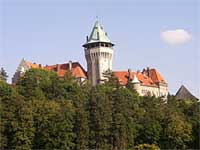 |
Information exchange and discussions on research policy issues were the major items on the meeting agenda. Two-day working sessions included presentations from major nuclear shareholders in the Slovak nuclear power sector - Slovenske elektrarne - Enel, VUJE, Inc. and Javys, Inc. They were followed by presentations from top-level guest speakers that focused on the most important related issues driving the European energy scene. Chairman of Board and CEO of Slovenske Elektrarne - Enel, Paolo Ruzzini, confirmed that agreements with contractors in the project for the completion of Mochovce Units 3 and 4 would be signed on July 11, 2009. Representatives of EAES member states then presented their respective national reports.
Among the guest speakers was Marc Deffrennes (EC Section Head, DG-TREN), Francois Nguyen (IEA Senior Policy Advisor - Electricity Markets), Andrej Stritar (HLG Chairman & Director of URSJV), Bernard Castanet (Areva, Vice-President New Projects Development) and Yves Kaluzny (CEA/DEN Senior Vice President). Views and attitudes that may affect the direction of research in EAES member states and, hopefully, influence some political decision-makers were outlined and developed during the constructive discussions that followed.
At this year’s Council meeting the Director of the Nuclear Safety Division at VUJE, Inc., Peter Liska, was elected President of EAES, taking over from his predecessor, Professor Mauricio Cumo of Italia Sogin, S.p.a.
The meeting agenda was combined with a number of interesting social activities for the participants and their spouses, including a dinner and wine tasting session. The last day of the event was devoted to a technical visit of the recently closed units of V-1 Nuclear Power Plant at Bohunice, Western Slovakia. The visit was impressive and for many of participants it appeared barely comprehensible that such a plant had to be closed in such an untimely way.
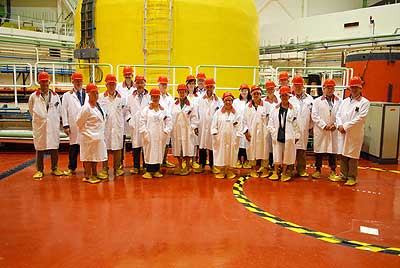
The EAES meeting was organised by Slovak company VUJE, Inc. an engineering and technical support organisation for Slovak NPPs, with the support of Slovenske Elektrarne - Enel and company Javys, Inc., companies that are all active in the nuclear decommissioning field.
Participants greatly appreciated the quality of the organisation of this year’s combined EAES meeting.
Juraj Klepac - Secretary General of the Slovak Nuclear Society
http://www.euronuclear.org/e-news/e-news-25/isarael.htm

On May 25, Professor Yigal Ronen, President of the Israel Nuclear Society, was granted an Honorary Doctor from the Russian Academy of Science, the highest award for an outstanding non-Russian scientist; he is the only scientist receiving this award in 2009.
Prof. Ronen was for many years Head of the Department of Nuclear Engineering in Ben-Gurion University, later Vice-Rector of the University and Dean of the Faculty of Engineering Science. He was Visiting Scientist and Visiting Professor in Oak Ridge National Laboratory, Swiss Federal Institute for Reactor Research, Cambridge University, Universidad Politecnica de Madrid, Tokyo Institute of Technology, Kernforschungszentrum Karlsruhe and Texas A&M University.
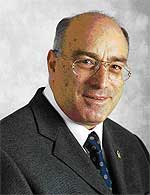 |
He is a Fellow of the American Nuclear Society, Foreign Member of A.M. Prokhorov Russian Academy of Engineering Sciences, Honorary Doctor of St. Petersburg Polytechnic State University and of the Russian Academy of Science. Prof. Ronen published nearly 200 scientific articles, mostly on Nuclear Science and Engineering, Reactors, Fusion, but also on Archeology and Philosophy of Science. In the same realm did he contribute in the writing of several books and wrote a book himself. |
Finally, he accomplished quite a few "firsts", among them "The discovery of the 27-N nuclear correlations", known as Ronen's Correlation, and "Suggesting a rule for Cluster Radioactivity", known as Ronen's GoldenRule for Cluster Radioactivity.
http://www.euronuclear.org/e-news/e-news-25/forsmark.htm

|
SKB, Sweden’s nuclear fuel and waste management company, decided on 3 June 2009 to build its final repository for spent nuclear fuel at Forsmark. The waste disposal facility, which could be completed in 2015, should be the first permanent disposal for high level waste (HLW) to be built in the world. It has taken around 20 years to eventually make |
a decision on where to build the facility. The company had to choose between Forsmark in the municipality of Östhammar and Laxemar, in the municipality of Öskarshamn. The next stage is for SKB to send in 2010 applications for permits to the Swedish Radiation Safety Authority and the Environmental Court. The applications include the environmental impact assessment and a safety analysis for a nuclear fuel repository in Forsmark. Swedish high-level waste will be disposed of in the final repository in crystalline bedrock at a depth of nearly 500 m.
For the high-level waste, there is broad consensus in Europe that deep geological disposal is the best applicable technical solution. Finland, Sweden, Switzerland and France have taken the political decision to assess the deep geological disposal option and are close to authorising the construction and starting up of sites. Switzerland and France are still in the process of selecting a site for the facility. Other countries are actively considering this option. The rock formations most studied for deep disposal are clay (in Belgium, France, Germany and Switzerland), crystalline rocks (Sweden, Finland and Switzerland) and salt (Germany).
In 2001, a governmental decision in principle was ratified by the Finnish Parliament. It states that the location of the future final repository will be in Olkiluoto, Eurajoki. The facility is expected to start by 2020. In Switzerland, the Federal Council adopted on 2 April 2008 a plan to construct deep geological repositories. The selection of the site is currently being carried out. NAGRA, the Swiss waste management company, has already proposed potential sites. The 2006 French law on radioactive waste management provides that a deep geological repository for high-level waste should be built by 2025. The law also indicates that waste has to be retrievable.
In other European countries such as Belgium, Germany and the UK, research is being carried out and different options are being investigated, but no decision has been taken yet as regards final disposal of high-level waste. In any case, solutions do exist and it is only a matter of political will to decide which one is the most appropriate.
For further information on the Swedish decision, you can read SKB's press release. For more information on deep geological repositories, please consult the EIG EURIDICE website.
Here is a breakdown of the current situation in Europe regarding deep geological disposal;
| Company | Decision | Location | Research | Start | Type | |
| Belgium | ONDRAF | Decision in-principle expected by 2011 |
Not known | Mol, Hades DGR (clay) | Not known | Not know |
| Finland | POSIVA | 2001: Decision in-principle | Olkiluoto (2001) | None | 2020 | DGR (crystalline bedrock) |
| France | ANDRA | 2006: law on RWM | Selection in process | Bure (Meuse) DGR (clay) | 2025 | DGR (retrievability) |
| Germany | BFS | None | Not known | Gorleben DGR (salt) | Not Known | Not know |
| Sweden | SKB | 1977: Stipulation Law 2001-2002 approval of DGD |
Forsmark (2009) | Äspö Hard Rock Laboratory (DGR) | 2015 | DGR |
| Switzerland | NAGRA | 2008: Plan to build DGR | Selection in process | Grimsel pass (Canton Bern): DGR (clay) | Not Known | DGR |
| UK | NDA | 2008: White Paper on RWM (framework for GD) | Not known | None | Not Known | DGR |
(DGR: deep geological repository; RWM: radioactive waste management; GD: geological disposal)
http://www.euronuclear.org/e-news/e-news-25/pollution.htm

The following text is a translation/adaptation that I have made of an interesting advisory report by France’s High-level Committee for Transparency and Information on Nuclear Safety (HCTISN) that was published in the November-December of the trade journal Revue Générale Nucléaire. The text was kindly forwarded to me by our friends at SFEN. Although the report was published last autumn it received little press coverage and the findings of the HCTISN make interesting reading. More information is available on SFEN’s website at: www.sfen.org.
A report by the High-level Committee for Transparency and Information on Nuclear Safety (HCTISN).
Levels of pollution measured around France’s nuclear sites – both civil and military – are very low. They “do not require that any special measures be taken as far as the local environment and the general public are concerned.” This is one of the main conclusions drawn by France’s High-level Committee for Transparency and Information on Nuclear Safety (HCTISN) in an advisory report delivered to Jean Louis Borloo, France’s Minister of State for Ecology and Sustainable Development, on 7 November 2009. The report was intended to provide a definitive response to what became referred to as the “Tricastin events.” The event, which occurred in the summer of 2008, related to an accidental leak of liquid effluents containing about 74kg of natural uranium on the site run by SOCATRI. The majority of the effluents were transported via local water sources adjacent to the site down to the river Rhône. The incident, which was classified as Level 1 on the INES scale, solicited considerable media attention, with some newspapers writing rather alarmist articles claiming that very serious pollution of the environment had taken place – not only of the surface water, but also of the groundwater - in the immediate vicinity of the site.
In order to respond to the anxiety expressed by local inhabitants and, more generally, to guarantee the communication of transparent information on the radio-ecological status of nuclear sites in general and on the management of old radioactive waste disposal sites, Minister of State Borloo, who is responsible for environmental incidents, decided to ask the HCTISN to investigate the incident. In addition to asking the HCTSIN to give its recommendations with regards to the incident that occurred on 7 July 2008, and what happened afterwards, Minister Borloo asked the High-Level Committee to advise the government on “the radio-ecological follow-up at all France’s nuclear sites” and on “how old disposal sites for radioactive waste are managed.” He wanted the investigations to look in particular at “the quality of information that is made available to the general public, how transparent the public information process is and what needs to be done to get all the various stakeholders involved in the process.”
To put together its recommendations the HCTISN first organised hearings to listen to what the main stakeholders has to say, i.e. the safety and inspection authorities, technical experts and the main operators from the nuclear sector. In parallel to these hearings the High-Level Committee studied the very detailed reports that Henri Revol, its President, had asked the stakeholders to submit. This job of studying them and formulating recommendations was carried out by a Working Group presided over by Monique Sené, from the association of local information committees (CLI).
Responding directly to public anxiety about possible pollution of groundwater around nuclear sites the HCTISN, basing its findings on the summaries written by the inspection authorities, established very clearly that “the radio-ecological status of the groundwater underneath and around nuclear sites does not pose any significant environmental or healthcare problem.” This conclusion, which was drawn up by the highest authority responsible for ensuring transparency of information with regards to nuclear safety, is an important contribution to the energy debate in France. It does not reveal any significant new data on the subject because environmental protection specialists – whether they are working in the nuclear sector or not – know full well that that overall the level of radioactive pollution measured at civil and military sites is very low. However, it is the first time that a judgement of “non pollution” has been delivered with such “solemnity,” with an official recommendation sent to the government by an independent body mandated to give its advice on the situation. It is worth mentioning in passing that the opinion of the HCTISN was reached after a consensus had been reached, without a vote having been necessary. Thus is all the more remarkable bearing in mind the fact that the HCTISN includes a significant number of members well-known for their anti-nuclear views.
So, a few months after a wave of media coverage on the potential contamination of the groundwater, recommendations were put forward that dismissed the rumours and were intended to reassure local inhabitants. It goes without saying that the recommendations did not receive any media attention because the media only report on “good news” with the utmost reluctance. This is yet another illustration of how for many media outlets it is only worrying news, and not reassuring news, that makes good copy.
The recommendation of the HCTISN is backed up by radio-ecological measurements that were made at a number of nuclear sites. As the High-Level Committee states: “these measurements are mostly linked either to older nuclear activities, which began at a time when environmental considerations were less important and standards less stringent, or to isolated operational incidents. In a few cases, it cannot be discounted the that further radioactive substances might have continuously been added to pre-existing cases of pollution.”
The report goes on to say: “The status of groundwater and surface water around nuclear sites is generally well-known. Pollution and contamination levels have been the subject of longstanding and rigorous inspection and, if necessary, to further investigation and action aimed at limiting their spread or reducing their impact. This is the case at the following sites (as mentioned in reports submitted by the ASN, ASND and IRSN – various national nuclear inspection and control authorities): La Hague (ANDRA-AREVA), MARCOULE (CEA), SACLAY (CEA), TRICASTIN (AREVA), VEUREY-VOROIZE (SICN), VALDUC (CEA), BRUYERES-LE-CHATEL (CEA).”
In addition to this appreciation of the radio-ecological status at nuclear sites, and of the relevant information that was communicated about it, the HCTISN, in accordance with the judicial authority vested in it, is required to deliver a recommendation on the quality and transparency of the pertinent information communicated to the public. Within this context the HCTISN considers, with respect to the radio-ecological status of both nuclear sites and radioactive waste storage facilities, that the information delivered is “abundant and varied.” However, in many case this information is “difficult to access, sparse, disordered and compartmentalized.”
To improve this situation the HTCISN formulated 18 recommendations, which the Ministry agreed to take responsibility for. These recommendations focus essentially on three areas:
Making the information more comprehensible and accessible to the public:
by developing an internet portal that allows easy access to the information
by developing a scale of communications that is adapted to include information on cases of radio-ecological environmental pollution
Increasing the role of the local information committees (CLI).
Thanks to their pluralistic make-up these committees should play a leading role at local level by encouraging the spread of information and favouring consultation with stakeholders (these committees should be created at storage facilities where naturally radioactive waste is stored and where there are important environmental and societal issues at stake).
Developing a diverse and independent body of expertise.
A varied and independent source of expertise from among those whose expertise is usually called upon in cases involving the nuclear industry. This recommendation could be very quickly put into action.
For a more detailed look at the report, the individuals involved in the work of the HCTISN and the 18 recommendations of the HCTISN (it would have been too exhaustive to include them all in this translation) consult the SFEN website mentioned above (bottom of the home page) or read a copy of the Revue Générale Nucléaire of November-December 2008.
Mark O’Donovan
http://www.euronuclear.org/e-news/e-news-25/sweden.htm

The Swedish Government recently asked Parliament to allow the power output at Sweden’s existing nuclear reactors to be increased, as well as to grant an eventual life-time extension for some of them.
andPersson(R).jpg)
In Sweden about half of electricity provision comes from nuclear power. When the weather allows it wind power also contributes to electricity production. The rest is supplied by hydropower.
Wind power has been used by man for centuries, but it is not without controversy. It is intermittent and unreliable. Many people dislike the noise turbines make and it requires vast amounts of space because the turbines must be located at a set distance from each other in order to avoid “stealing” wind from their neighbors. Also the economy rating is poor because a lot of steel is needed for the construction and expensive electrical equipment is required for the electricity transmission. Furthermore, instant back-up capacity must always be available.
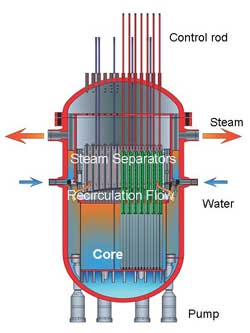
At the moment Sweden is hosting many European Union conferences and meetings. One of the main points on the agenda is environmental protection, notably by decreasing the burning of coal and oil to reduce the release of harmful greenhouse gases into the air. Many types of transportation can also be powered by using less fossil fuels and more non CO2-emitting electricity generating sources.
Neighboring Finland is building a new nuclear power plant. Another plant is planed in Loviisa, in southern Finland, and several communities in the north have expressed willingness to host a new power plant.
A powerful transmission cable is planned to link Sweden to the Baltic region in order to enable the latter to connect to the Nordic electricity grid. This will enable the Baltic countries to become integrated with the European Union’s energy system.
The Swedish government has allowed the currently operating reactors be replaced with new ones. The industry has responded by indicating that Oskarshamn 1 and Ringhals 1 would be the first ones to be replaced.
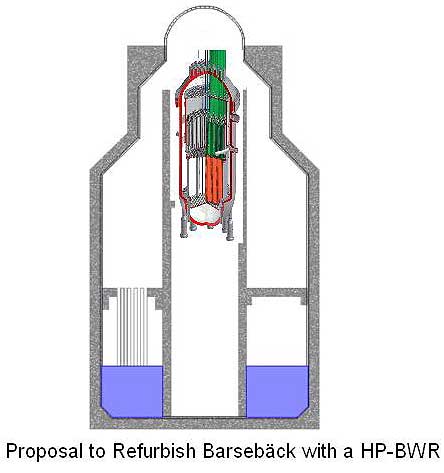
To minimize costs currently used buildings could be retained and a new concept applied to include the installation of an environmentally-friendly, safer and more economical reactor, like the High Pressure Boiling Water Reactor, HP-BWR. Information on HP-BWRs was previously presented in ENS NEWS in July 2008. Here is the link: www.euronuclear.org/e-news/e-news-21/concept-of-the-future.htm
The Barsebäck 1 reactor was closed ten years ago. Radiation in the reactor and its vicinity has greatly decreased since then as many components have been removed. It would be easy to refurbish the plant and install an HP-BWR, providing there was a change in policy. One thing’s for sure, nuclear power will remain in Sweden.
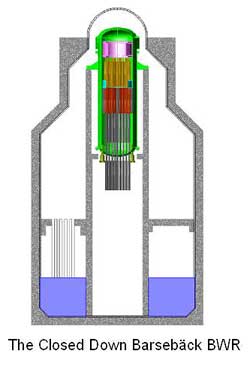
Frigyes Reisch and Lars Persson, Stockholm, Sweden.
http://www.euronuclear.org/e-news/e-news-25/GUINEVERE.htm

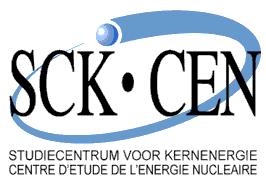
As mentioned in ENS N° 21 (summer 2008), SCK•CEN (the Belgian Nuclear Research Centre) is a candidate for hosting a European fast-spectrum experimental facility for demonstrating efficient transmutation and associated technologies using a system that works in sub-critical and/or critical mode. With this in mind, SCK•CEN started, in 1998, designing the MYRRHA facility as an accelerator-driven system (ADS) with the following objectives:
To demonstrate ADS technology, full-scale, within the framework of research into the transmutation of high-level radioactive waste
To serve as a flexible fast-spectrum irradiation facility for testing materials and innovative fuels for ADS and GEN IV systems and fusion reactors
To contribute to the technological demonstration of the GEN IV Lead Fast Reactor
To perform fundamental and applied physics research making use of SCK•CEN's high-power proton accelerator
As a first step towards the development of MYRRHA, the GUINEVERE project (Generator of Uninterrupted Intense NEutrons at the lead VEnus REactor) was launched. GUINEVERE is part of the EUROTRANS Integrated Project (6th EURATOM Framework Programme). EUROTRANS collects feasibility and design studies for an ADS demonstrator, as well as its possible extension for use in an industrial transmutation installation. GUINEVERE aims to provide a zero power experiment which will investigate online reactivity monitoring and absolute reactivity measurements, both of which are major issues for ADS safety.
To do so the VENUS reactor of SCK•CEN (at Mol) will be coupled to a neutron source driven by the GENEPI-3C deuteron accelerator. This accelerator will not only be operated in pulsed mode, but also in continuous mode, the latter being the more representative of a powerful ADS. Thanks to the flexibility of the GENEPI accelerator VENUS will provide a unique facility in Europe where it will be possible to investigate both fast-critical and subcritical reactor.
The VENUS reactor was a zero power thermal critical mock-up until 2007. From then on it has been dedicated to the GUINEVERE experimental programme and, therefore, it had to be changed into a lead fast reactor called VENUS-F.
The VENUS-F core will consist of fuel assemblies (FA) arranged in a cylindrical geometry of ~80 cm in diameter and 60 cm in height. Each FA is composed of a combination of round fuel rodlets and of square solid lead rodlets which constitute a fast system coolant. These rodlets are arranged in a 5x5 pattern. Lead plates are added around the pattern in order to decrease the fuel/coolant ratio (and hence to increase the core size). In total a FA is 80 mm wide. A cross section is shown in fig. 1. The fuel is provided by CEA, and it consists of 30%
235U enriched metallic uranium. The core is expected to become critical with 88 FA's installed.

Fig. 1: Cross section of the FA pattern chosen for the VENUS-F core:
Yellow circles: fuel rodlets; green squares: lead.
The core will be surrounded by two 40 cm axial and radial lead reflectors. At the centre of the core a channel can be arranged with a stainless steel shaft for the insertion of the final part of the accelerator beam line, including the target and its cooling system. In order to allow for sufficient space, but keeping the simple and symmetric geometry, this channel is chosen to have the cross section of 4 standard FA’s. A small lead buffer is foreseen to fill the gap between the target tube shaft and the 160x160 mm2 central hole. Fig. 2 shows a radial view of the reactor at its mid-plane (only the inner parts of the vessel are shown), in a configuration with 84 FA's and keff ~ 0.97.
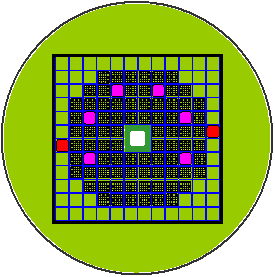
Fig. 2: Cross section (mid-plane) of the sub-critical core configuration (84 FA’s).
A new shut-down system had to be implemented for the fast neutron reactor. It is based on the standard philosophy of safety rods falling in the core under the influence of gravity when the signal for de-energizing the electromagnets is received. The safety rods consist of a neutron absorbing material (B4C with natural boron), 60 cm long, and it features a fuel follower which has the same pattern as shown in Fig. 1. When a safety rod is up its fuel follower reaches the height of the core, thereby eliminating core perturbations; when a safety rod drops an anti-reactivity is inserted by the combined effect of removing fuel and inserting absorber material. In total 6 safety rods are foreseen at fixed positions in the core. The control rods on the other hand only contain an absorber part that slides inside a wrapper tube. Their number and the choice of their position are flexible. A typical configuration is shown in fig. 2.
The accelerator beam access was chosen to be vertical in order to preserve the cylindrical symmetry. But due to the small size of the reactor (160 cm in diameter) it was not possible to host the accelerator at the reactor top level. Therefore, the VENUS reactor building had to be modified by adding a dedicated room for the accelerator at an upper level (see Fig. 3). Civil engineering work at the VENUS building was started on September 1, 2008, and it was completed at the beginning of March 2009. Electrical power equipment and ventilation systems will be ready by the end of the summer 2009, and the accelerator will be installed from September 2009 onwards.
The accelerator called GENEPI-3C (GEnérateur de NEutrons Pulsé Intense-3Continu) is the third of a series that is explicitly foreseen for neutron experiments. It has been designed and built by a CNRS/IN2P3 (France) partnership and is being assembled and fully tested at the LPSC in Grenoble. Full commissioning and the beam characterization at the final target will be ready by the summer 2009. After that it will be disassembled for transportation to SCK•CEN in Mol, and reassembled in the VENUS-F reactor building.
The machines of the GENEPI family are 250 kV electrostatic accelerators. They are fitted with a duoplasmatron ion source, and they deliver a deuteron beam to a copper target with a titanium-tritium (TiT) or a titanium-deuterium (TiD) deposit. In this way they provide 14 MeV or 2.5 MeV neutrons via the T(d,n)4He or D(d,n)3He reaction, respectively. The first GENEPI acceleator was designed for the MUSE experimental programme at the MASURCA reactor (CEA Cadarache, France, 2000-2004). It operated in pulsed mode only, with a peak
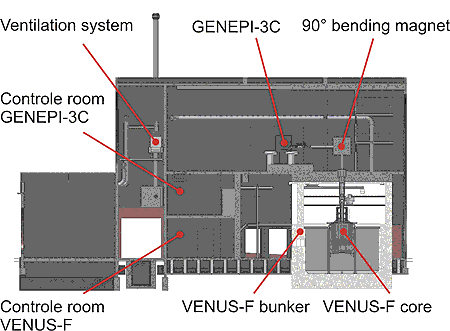
Fig. 3: Side view of the modified VENUS facility.
current in the pulse of 50 mA and a pulse length of the order of 1 ms. The new GENEPI-3C machine repeats these specifications and adds a continuous mode, with a maximum DC beam current of 1 mA. Furthermore, it will be possible to generate programmable beam interruptions with steep falling and rising times in a flexible way.
A general layout of the machine with its supporting structures is shown in fig. 4. The vertical beam line, ended by the target, is obviously partly inserted in the reactor. In order to exchange targets and for beam line maintenance, but also for reactor maintenance and reconfiguration, the entire vertical beam line must be removed. So, it is necessary to raise this beam line, which is fixed in a dedicated support structure, up to a level above the floor of the accelerator room. This is achieved by means of a crane and adequate guiding tools. Upon arrival in the accelerator room it is then stored in a stand and surrounded by working platforms. To allow for this operation the 90° bending magnet gets displaced over 2 sliding rail tracks.
The GUINEVERE experiment will make important contributions to the fields of calculation code validation for ADS applications and to the methodology for online reactivity monitoring in an ADS. The main issue here is the validation of the direct relation between the beam intensity and the power level of the reactor as an online reactivity indicator. The corresponding experimental programme has been fixed within the EUROTRANS collaboration,
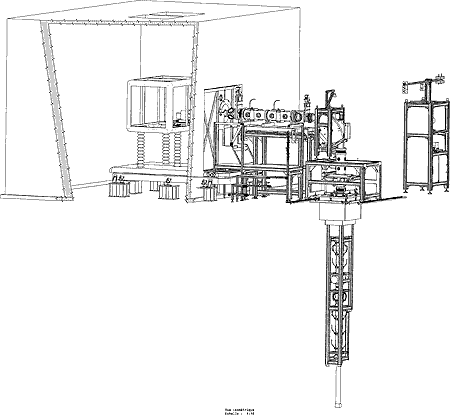
Fig. 4: General layout of the GENEPI-3C machine with its supporting structures.
and consists of 2 phases. In the initial phase the VENUS-F reactor will be operated and fully characterized in its critical mode, so as to provide a solid reference for the subsequent ADS experiments. The second phase then uses the subcritical configuration and the coupling to the accelerator using a tritium target. During this phase 3 types of experiments are planned, each type corresponding to a specific time structure of the deuteron beam and thus of the neutron source. In order to relate to the earlier MUSE experiments the pulsed beam is used with a pulse length of around 1 ms. After the pulse the time evolution of the neutron population in the core is recorded, and its analysis yields an estimation of the reactivity. Then, in a second experiment, this method is applied to a situation in which the time structure of the beam is basically continuous but with interruptions at regular intervals. The "beam on" periods are chosen long enough to reach a steady state situation. The "beam off" interruptions may be chosen as either short (around 200 ms, see fig. 5) or long (around 2 ms), corresponding to 2 distinct ways of analysing the decay of the core neutron population and obtaining the reactivity. Finally, the true continuous beam will be used at several levels of current in order to obtain the relationship between beam intensity and neutron flux, and to validate this method as a truly online reactivity measurement for ADS applications.
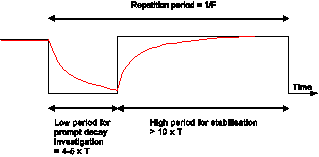
Fig. 5: The principle of prompt decay signals at a short beam interruption (black: beam current, red: neutron flux).
Contacts:
Dirk Vandeplassche (dirk.vandeplassche@sckcen.be)
Peter Baeten (peter.baeten@sckcen.be)
www.sckcen.be
http://www.euronuclear.org/e-news/e-news-25/sne.htm


The Consejo de Seguridad Nuclear (CSN), Spain’s nuclear regulatory body, recently agreed unanimously to submit a report to the government with a non-binding recommendation that the Santa María de Garoña nuclear power plant should operate beyond its original 40-year-lifespan and this for a further period of 10 years. This decision was taken on 8 June after three years of analysis of the documentation that was presented on the plant, and following six plenary meetings of the CSN. The results of the analyses were detailed in the working programme that the CSN published on 16 April 16.
Santa María de Garoña is a 466 Megawatts capacity BWR nuclear power plant located in the north of Spain, in the province of Burgos. It was constructed by General Electric USA (GE) and first started operating in 1971. In accordance with Spanish legislation, for the license renewal of the NPP Endesa and Iberdrola, who operate the plant under a joint venture known as Nuclenor, launched an investment plan some years ago. This was based upon a lifetime extension of the plant, with a continuously updated programme that conforms with the rules applicable to the construction of a new NPP.
The Santa María de Garoña NPP was among the first 10 NPPs to be built in Europe and ranks 50th out of the 440 operating worldwide when it comes to achieving its operational targets. In the US eight plants that are similar to Garoña NPP and of a similar operating age have already obtained permission to extend their operational lifetime to 60 years. One of these plants, 'Oyster Creek,' is already more than 40 years old.
The CSN recommended the extension on condition that Nuclenor implement a series of measures by 2013 to improve safety at the plant. As the report is a non-binding recommendation the government will now have to decide by 5 July whether it will extend the authorisation to Nuclenor to operate the plant until 2021.
An important debate on the government’s decision has begun in Spain because, according to Teresa Dominguez, President of Foro Nuclear (the Spanish nuclear industry forum): “An extension of the operating permit of Garoña would provide a benchmark for the other nuclear installations in our country.”
The Spanish Nuclear Society outlined the opinion of its members on the subject in a report that you can read at: www.sne.es
For more information on this topic, visit www.csn.es and the web sites of the institutions and companies mentioned in this report.

On May 26, the traditional Spring Meeting of the SNE was held in the Industrial and Telecommunications Engineering School of the University of Cantabria. The aim of this meeting was to present the SNE's activities to university students in the region with a view to showing them the vitality of the Spanish nuclear sector within an international context.
The inaugural presentation was given by Javier Tovar, Director of Organization and Quality of ENSA, the main nuclear sector company in the area, and José Emeterio Gutiérrez, SNE’s President, in the presence of the Dean of the University of Cantabria, which emphasised the importance of this type of meeting when it comes to linking universities with the industry.
Representatives of the main Spanish engineering companies that are active in nuclear sector also participated in the session and showed that the Spanish nuclear industry has been able to maintain its position despite a lack of possibilities in the national market. This was achieved by prospecting new markets and by showing a high level competitiveness in different sub-sectors like fuel fabrication, engineering and others.
The Director of the Industrial and Telecommunications Engineering School of the University of Cantabria (Eduardo Mora) and the General Director of Industry of the Comunidad de Cantabria (Marcos Bergua) closed the session by emphasising the importance of communicating with university students, who represent some of the future professionals that will one day work for these companies.

The aim of the Annual Event of the New Energy Technologies Chair 'Rafael Mariño' at the Polytechnic University of Comillas (Madrid) is to discuss in-depth the situation with regards to the different energy sources that are essential for the country’s development and to highlight the problems that each source faces.
This year’s event was devoted to nuclear energy and its role as an energy model for achieving sustainable development with minimal environmental impact. Several European countries - including France, the UK, Italy, Finland and Russia – as well as Asian countries like Japan, China and India, are seriously considering nuclear energy as an absolutely essential energy option (together with the renewable energies). So too are the US.At the same time, the participation of fossil resources in the mix is decreasing. Within this context the meeting sessions highlighted the different aspects of nuclear energy and its related technology, showing clearly its capacity for solving the problems that can occur.
The event was divided in five modules during which the following topics were discussed: Waste Management and Transport; Transmutation and Reprocessing; Nuclear Power Plants: Operational Life -time Management; the Spanish Nuclear Energy Industry: Socio-economic aspects of nuclear energy and Generation III Nuclear Power Plants.

The 35th Annual Meeting of the Spanish Nuclear Society will be at the Barceló Renacimiento Hotel, in Seville, from 28 - 30 October, 2009. The Technical Committee has already closed the period allowed for receiving abstracts and the final version papers must be submitted before to 15 July. The meeting agenda includes both plenary and technical sessions.
The Plenary sessions, which include opening, closing and special sessions, will focus on current important issues as follows:
Plenary 1: 29 October
Spanish Energy Perspectives for 2030: This session, in which senior representatives of the different energy resource sectors will participate, will focus on the complementarity between renewable energies and nuclear energy.
Plenary 2: 30 October
New Nuclear Programmes: Representatives of the companies and institutions involved in new nuclear programmes will present the innovative aspects of these programmes.
The Technical Sessions will continue throughout all three days of the Annual Meeting and will be grouped by topic. During these sessions nuclear professionals from Spain and other countries will showcase their developments. The Technical topics to be covered at the 35th Annual Meeting are the following: fuel, communications, dismantling, fusion, R+D, engineering, maintenance, nuclear medicine and other applications, new reactors, NPP operation, management and human factors, radiological and environmental protection, nuclear waste and nuclear safety.
More than 220 presentations are expected to be given during the Technical Sessions this year. The Monograph Sessions are devoted to specific topics and bring together specialists from all over the world. The agenda topics here are:
Long-term operation
Impact on the American nuclear industry of the DOE activities
Forward-looking markets
Public acceptance of the nuclear energy
Nuclear power plants staff training
Innovation in waste management
The Technical programme will conclude with a series of courses entitled Learn more about that deal in a very practical way with topics of particular interest. This year the courses on offer are:
Is there enough uranium?
Fuel load planning
Operation of the electric market
In the commercial exhibition that will take place in parallel during the three days of the meeting more than twenty companies and institutions related to the nuclear industry, nuclear research and services sectors will present their main innovations. The exhibition will also be held at the Barceló Renacimiento Hotel.
http://www.euronuclear.org/e-news/e-news-25/enygf09.htm


The third European Nuclear Young Generation Forum (ENYGF 09) took place in Cordoba, Spain, from 19-23 May 2009. Under the banner headline: “Maybe we cannot build the future for us now, but we can build us for the future now”, the Spanish Young Generation organized this major event that is dedicated to young and senior nuclear professionals from across Europe. The location of the conference was the University of Cordoba, which has been recently renovated in the traditional Spanish architectural style, with Moorish influences.
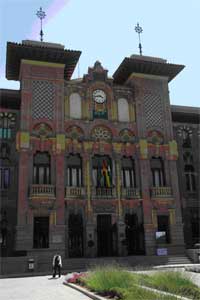
The focus of ENYGF09 was the provision of the training and education needed to prepare tomorrow’s nuclear leaders, and the creation of a communications bridge between the older and the younger generations in order to facilitate the transfer of knowledge.
Nowadays, nuclear energy is faced with three major challenges, according to Jose Emeterio Gutierrez, Chairman of the Spanish Nuclear Society: the revitalization of the industry, the transfer of knowledge and the safety of the present fleet of nuclear reactors. In order to face these challenges nuclear power must benefit from political and social consensus in the countries that want to develop a nuclear programme.
The Forum consisted of two days of conference sessions divided by a technical tour to the El Cabril radioactive waste repository. On 20 May, the conference brought to the attention of the public the necessity of having nuclear power and the major role that it will play in Europe’s energy future. The conference was opened with a series of keynote speeches given by David Bonser, Chairman of the European Nuclear Society, Jose Manuel Roldan from Cordoba University and Jose Emeterio Gutierrez. The keynote speakers pointed out the importance of having a common platform for nuclear power and renewable energy sources in order to gurantee Europe’s energy future.
The first plenary session, chaired by Luis Echavarri, Director General of the OCDE-NEA, was dedicated to a discussion of the role that stakeholders play in the deployment of nuclear energy in Europe. It included presentations from the main sponsors and promoters of ENYGF09, who shared their experiences and views on the issue.
Alejo Vidal-Quadras MEP (EPP-ED, Spain) and former Vice President of the European Parliament underlined the fact that energy is beneficial for everyone and can provide a solution to the problems of global warming, security of energy supply and European competitiveness. Nuclear energy ensures almost 16% of the current energy mix and, according to Tony Granda of AREVA, it is foreseen that by 2030 about 500 GWe will be generated by nuclear reactors.
The main conclusion of the first session was that for nuclear to have a bright future and increase its output the existing fleet of reactors must be safely operated, without any incidents.
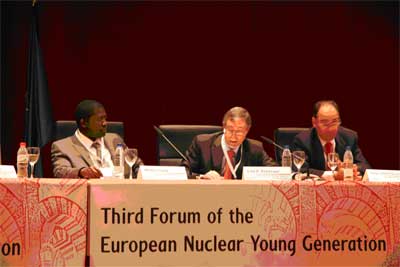
The afternoon session concentrated on the “drivers of nuclear energy acceptance” and the connection between public information and public acceptance. The papers presented by Fennovoima, SKB, FORATOM, SCK-CEN and the Spanish Young Generation pointed out that public perception of nuclear safety is influenced by nuclear plants’ safety track record and by the commitment that is shown to resolve the issue of nuclear waste. According to the presentation given by Berta Picamal of FORATOM, nuclear energy is a “back-of-the-mind” issue and this is the reason why public opinion on nuclear can be easily influenced.
The President of the Spanish Young Generation (SYG) gave a presentation about the hands-on activities that SYG has initiated to help gain greater public support for nuclear in Spain. Spain and Romania are the only two countries in the UE that have nuclear power stations and a low acceptance of nuclear power, with 24% and 35 % respectively. In order to gain the public’s trust it is important for Young Generation chapters to separate their interests from those of the nuclear companies. Also, information must be reliable, reader-friendly and address people’s concerns.
The day finished with a visit to the Cordoba Mosque and dinner in a winery to the accompaniment of flamenco music.
The following day the technical tour to the El Cabril low and intermediate level radioactive waste repository (a subsidiary of Enresa) took place. This repository receives approximately 2000 m3 of radioactive waste per year from Spain and can guarantee the safe storage of waste until 2020. After this date the site will be restored to its original state and protection will be provided for a further 300 years. The visit was followed by an equine demonstration and dinner at an oil mill that introduced participants to many aspects of Spanish culture.
The last day of conference was marked by the poster session that took place in the main hall and by the awarding of the Jan Runemark Award to a respected and successful promoter and supporter of Young Generation activities. I had the pleasure of taking to Mr. Marcel Maris while visiting the old city center in Cordoba, without knowing that he was about to receive the award. He gave me the impression of being a young and energetic man. The Jan Runemark Award was created by ENS’ Steering Committee in 1995 in memory of the founder of the Swedish Young Generation Network. This year’s winner, Marcel Maris, has given considerable support to the Belgian Young Generation during his time as Chairman of the Belgium Nuclear Society (2006-2007). Currently, he is leading the recruitment and training process for Bel V. The principles he developed and implemented during that time encouraged knowledge and competence and helped greatly to promote the transfer of knowledge between nuclear generations.
The plenary session entitled “Getting stronger: Crucial lessons” presented a number of cases studies in which challenging tasks were met resolved by the industry, including companies like CEZ, EDF and organizations like CEA and EPRI.
According to a presentation given by Franck Carre of CEA, the candidate reactor technologies that should consolidate the future of nuclear energy in Europe are the EPR (AREVA), the AP 1000 (Westinghouse) and the APWR (Mitsubishi). He also mentioned the sodium-cooled fast breeder reactors, of which there are 18 experimental prototypes.
Petr Stulc of CEZ stressed the advantage of nuclear energy’s price stability and how it is a key element in promoting this type of energy.
The final session was a debate on the ethics and physics of the linear non-threshold hypothesis, from the perspective of university professors. This theory was elaborated by Herman Muller to show that there is a threshold between the positive and negative impacts of radiation. Low-dose radiation stimulates the body’s protective mechanism, which contributes to the repair of damage and helps eliminate seriously damaged cells. The participants in this session concluded that with effective communications this hypothesis could help expose the myths about the effects of radiation.
A farewell dinner took place on the final day of the conference amidst the beautiful scenery of Almodovar Castle.
The following day we visited the Alhambra castle, a legacy of the Moors’ presence in Spain between the 7th and the 15th centuries.
On 24 May, a Core Meeting of ENS Young Generation took place during which participants elected the new Chairman in the person of Edouard Hourcade, from CEA (France), as well as the new Vice-Chairman – Andrei Goicea from SN Nuclearelectrica SA (Romania).
In my opinion, the European Nuclear Young Generation Forum 2009 was a professional and social success due to the exchange of information that took place between the young generation and the older generation, the focus on communication strategies applied by different companies and the networking possibilities the forum offered during the social events.
And finally, it would be unfair not to mention the Cordoba Fair, which took place during the Forum and gave us a glimpse of the Spanish way of life, its energy and enthusiasm.
Rizea Lavinia Sandra
SN Nuclearelectrica SA (Romania)
http://www.euronuclear.org/e-news/e-news-25/ygn.htm

On June 3, Spain's nuclear safety regulatory body, CSN, declared unanimously that the Santa María de Garoña nuclear power plant, a BWR reactor, was “entirely compliant” with all the safety requirements needed to allow an extension of its operational lifetime to cover the period the 2009-2019 period. According to Spanish regulations, approval by the CSN is mandatory for the operation of any nuclear power plant. The CSN’s Resolution was announced after a careful and thorough evaluation process in which the daily operation of the nuclear power plant was analysed by a body of independent experts and technicians. Getting this approval is the main precondition for maintaining the operation of the power plant, but it is also necessary for the Ministry of Industry and the Spanish government to grant permission too.
The controversy surrounding Garoña has intensified due to the fact that the present government and, in particular, its President, has openly declared its desire to progressively shut down nuclear reactors in Spain. It wants, by so doing, to redraw Spain’s electricity generation map and place the main burden for energy production on the shoulders of renewable resources, a claim that has been highly disputed by experts and that has been considered as simply unfeasible by many.
The government has made no official statement yet, but President Zapatero has previously mentioned his preference for not renewing Garoña’s license once its forecasted lifespan of 40 years has come to an end. This decision will necessarily be connected to a previous decision made with regards to similar reactors in the US. However, in the US the outcome has been quite different, with more than 52 reactors having been granted life extensions and recently, the Oyster Creeek NPP, with an identical design to that of the Garoña NPP, was granted a lifetime extension up to 60 years. Indeed, more than 93% of the comparable reactors have obtained renewal licenses.
Maintaining Garoña NPP in operation for a further 10-year period would mean the extra production of more than 39,000 million CO2-free KWh of electricity. This would prevent the emission of more than 25,000 million tonnes of CO2. The NPP would provide the grid with a steady, reliable and low-cost production of electricity that could mean 1,600 millions € in energy savings from fossil fuels purchases.
Today Spain is one of the most energy-dependent countries in the world and is the European country that is furthest away from achieving its CO2 emissions reduction target.
The deadline for deciding on the fate of Garoña expires on July, 5. The Spanish government will have to decide soon, therefore, and in the midst of a deep economic crisis.
To face this scenario, the Spanish Young Generation Network recommends that the electricity supply be assured in the most secure way possible, at a reasonable and a stable cost. In other words by using nuclear energy. Furthermore, we believe that this would help make Spain as independent as possible of fossil fuel price hikes, thereby minimising its energy dependency. Such action would also help avoid a maximum amount of greenhouse gas emissions, thus enabling the effective management of waste resulting from electricity generation and – thanks to safe facilities - producing a positive economic and social impact in the neighbouring areas. We should not, therefore, reject any kind of energy resource.
Spanish Young Generation Network
http://www.euronuclear.org/e-news/e-news-25/boom-in-nuclear-qualifications.htm


The number of US students earning nuclear engineering degrees has increased for the fifth year in a row.
The data comes from the Oak Ridge Institute for Science and Education, which confirmed that the number of nuclear engineering degrees gained in the next few years is likely to remain at around at the same level. The report added that undergraduate enrolments for nuclear engineering courses had tripled between 2000 and 2008, but that the number still remained below those of the 1970s and early 1990s.

Continuous study was the number one aim of the majority of 2008's Bachelor-level graduates, with work at nuclear power companies coming second, service in the US military third, and 'other nuclear-related' work in fourth place. The USA has a very significant fleet of over 100 nuclear-powered naval vessels using broadly similar technology to that used in power plants. This leads to a great crossover of experienced staff whose military duties have ended.
For Masters-level graduates, continuous study was also the most popular next step, with 'other nuclear-related' work second and work for Department of Energy contractors in third place.
The institute said that numbers planning to enter the nuclear power industry had tripled since 2000 and reflected the annual numbers hired in the period up to 1998. Among the trends highlighted in the figures this increase "supports other information showing that there is increased interest in nuclear energy as a component of the economy and that there is a growing need to hire replacements to take over from an ageing nuclear workforce."
http://www.euronuclear.org/e-news/e-news-25/nucnet-news.htm


17 Jun (NucNet): A contract has been signed with the main suppliers for the completion of units 3 and 4 of Slovakia's Mochovce nuclear power plant.
Skoda of the Czech Republic said on 11 June 2009 that it had signed the contract with Slovakian utility Slovenské elektrárne (SE) after a two-year period of negotiations. Enel of Italy is the majority shareholder of SE, which owns the Mochovce plant.
Skoda is one of five main contractors for the completion project, the contract for which is worth more than 10 billion Czech crowns (about 375 million euro; 520 million US dollars).
Work on the completion of units 3 and 4 resumed in November 2008. Slovak prime minister Robert Fico attended a ceremony to mark the start of completion of the two Soviet-type VVER-440 pressurised water reactors.
16 Jun (NucNet): Russia's Federal Service for Ecological, Technological and Nuclear Supervision (Rostekhnadzor) has granted Energoatom Concern a licence for the construction of the third and fourth units of the Volgodonsk nuclear power plant (also known as Rostov).
The two units will be built at the existing Volgodonsk site, where one unit has been in commercial operation since 2001 and another is under construction.
The site was chosen in 1977 and the granting of the licence means preparatory site work can begin.
Rosatom, Russia's state nuclear energy corporation, said the new units will be type V-320 VVER reactors with improved steam generators and a gross generating capacity of 1,100 megawatts.
The construction of Volgodonsk-3 and -4 is part of a federal target for the development of Russia's nuclear industry until 2015.
12 Jun (NucNet): Energy legislation being proposed by US Republicans would include the construction of 100 nuclear units over the next 20 years as well as investment in renewables, alternative energy technologies and creating incentives for conservation.
US Congressman Mike Pence, chairman of the House Republican Conference, said in a statement this week that the Republican proposals would be an “all of the above” plan that offers energy independence, more jobs and a cleaner environment without imposing the national energy tax that has been proposed by Democrats.
Writing in ‘The Wall Street Journal’ yesterday, Mr Pence said legislation sponsored by Democrats to establish a cap-and-trade system that will sharply limit carbon-dioxide emissions would lead to higher energy prices.
“The cleanest way for utilities to control CO2 emissions is to increase the supply of carbon-free nuclear energy. This is obvious and simple, but in the thousand-page (Democrat) bill nuclear power is hardly mentioned,” Mr Pence said.
The Republicans’ proposed American Energy Act establishes a national goal of licensing 100 new nuclear reactors over the next 20 years. Mr Pence said that with 31 announced reactor applications already in the pipeline, this goal can be achieved – and it will revitalise an entire manufacturing sector, creating hundreds of thousands of jobs.
The proposed legislation also streamlines a cumbersome regulatory process by offering a two-year, fast-track approval programme for power plant applications that employ safe reactor designs already approved by the Nuclear Regulatory Commission (NRC).
“As for the problem of spent nuclear fuel rods, our bill emphasises safe storage and fuel recycling,” Mr Pence said. The NRC will be allowed to finish its review of a deep geological repository at Yucca Mountain in Nevada “without political interference”, and the federal government will be prevented from blocking other storage facilities if a state and locality choose to contract with a private company for that purpose.
The legislation also directs the Department of Energy to enter contracts with the private sector to recycle spent fuel, lessening the demand on Yucca Mountain and other sites.
Energy secretary Steven Chu has said Yucca Mountain “is not an option” for the disposal of nuclear waste.
http://www.euronuclear.org/e-news/e-news-25/other-conferences.htm

International Conference on Nuclear Engineering
12 - 16 July 2009
Sheraton Brussels Hotel, Brussels, Belgium
www.asmeconferences.org/icone17/

18th International Conference
14 - 17 September 2009
Bled, Slovenia
www.nss.si/bled2009/

13th International Topical Meeting on Nuclear Reactor Thermal Hydraulics
27 September - 3 October 2009
Kanazawa, Japan
Atomic Energy Society of Japan
3-7, Shimbashi 2-chome
Minato-ku
Tokyo 105-0004, Japan
Tel: +81-3-3508-1261
E-mail : atom@aesj.or.jp
www.nureth13.org/
5 - 9 October 2009
Barcelona, Spain
Online registration
![]()
12 - 16 October 2009
Buchares, Romania
Nuclear Energy Romanian Association – AREN
65 Polona Street
P.O. Box 22-102
010494 Bucharest -1,
ROMANIA
more

15 - 19 November 2009
Washington, DC
United States of America
American Nuclear Society Meetings
Department,
555 North Kensington Avenue, LaGrange Park,
IL 60326, USA
Tel: +1 (708) 352-6611
Fax +1 (708) 352-6464
E-mail meetings@ans.org
www.ans.org
7 - 11 December 2009
Kyoto, Japan
Conference Services Section
Division of Conference and Document Services
Tel: +43 1 2600 21311
Email: official.mail@iaea.org
www.fr09.org

16 - 20 May 2010
Dubrovnik, Croatia
Croatian Nuclear Society
Unska 3
10000 Zagreb,
Croatia
Tel: + 385 1 6129 627
E-mail: hnd@cro-nuclear.hr

29 August - September 2 2010
at the Shilo Inn Convention Center in Idaho Falls, Idaho, USA
Teri Ehresman
Assistant General Chair
Tel: (208) 526-7785
Fax: (208) 526-2930
Email: teri.ehresman@inl.gov
more
26 to 30 September 2010
Avignon, France
Patricia Hamel-Bloch
SFEN
5 rue des Morillons
F-75015 PARIS, France
Tel: 33.1.53.58.32.12
Fax: 33.1.53.58.32.11
Email: phamel-bloch@sfen.fr
more

9th International Conference on Tritium Science and Technology
24 - 29 October 2010
Nara, Japan
National Instiute for Fusion Science Safety and Environmental Research
http://www.euronuclear.org/e-news/e-news-25/Member-Societies.htm

Austrian
Nuclear Society |
Belgian
Nuclear Society |
Bulgarian
Nuclear Society |
Croatian
Nuclear Society |
Czech Nuclear Society |
Finnish
Nuclear Society |
French
Nuclear Energy Society (SFEN) |
German
Nuclear Society (KTG) |
Hungarian
Nuclear Society |
The
Israel Nuclear Society |
Italian
Nuclear Association |
Lithuanian
Nuclear Energy Association |
Netherlands Nuclear Society |
The Nuclear Institute |
Nuclear
Society of Russia |
Nuclear
Society of Serbia |
Nuclear
Society of Slovenia |
Polish
Nuclear Society |
Romanian
Nuclear Energy Association (AREN) |
Slovak
Nuclear Society |
Spanish
Nuclear Society |
Swedish
Nuclear Society |
Swiss
Nuclear Society |
http://www.euronuclear.org/e-news/e-news-25/Corporate-Members.htm

Links to ENS Corporate Members
|
http://www.euronuclear.org/e-news/e-news-25/editorial.htm
Mark O’Donovan, Editor-in-Chief
Contributors to this Issue:
Peter Baeten (SCK.CEN)
David Bonser (ENS)
David Dalton (NucNet)
Kirsten Epskamp (ENS)
Juraj Klepac, (SNS, Slovakia)
Rizea Lavinia Sandra (YGN)
Lars Persson (KTH)
Frigyes Reisch (KTH)
Andrew Teller (Areva)
Dirk Vandeplassche (SCK.CEN)
Realisation:
Marion Brünglinghaus
Rue Belliard 65, BE-1040 Brussels
Phone +32 2 505 30 50 - Fax: +32 2 502 39 02
E-mail: info@euronuclear.org - http://www.euronuclear.org
The ENS News is a quarterly publication, in electronic
form only.
Copyright notice ©2009 European Nuclear Society.
Reproduction is authorised provided that the ENS News is acknowledged as the
source – except where otherwise stated.
![]()
© European Nuclear Society, 2009